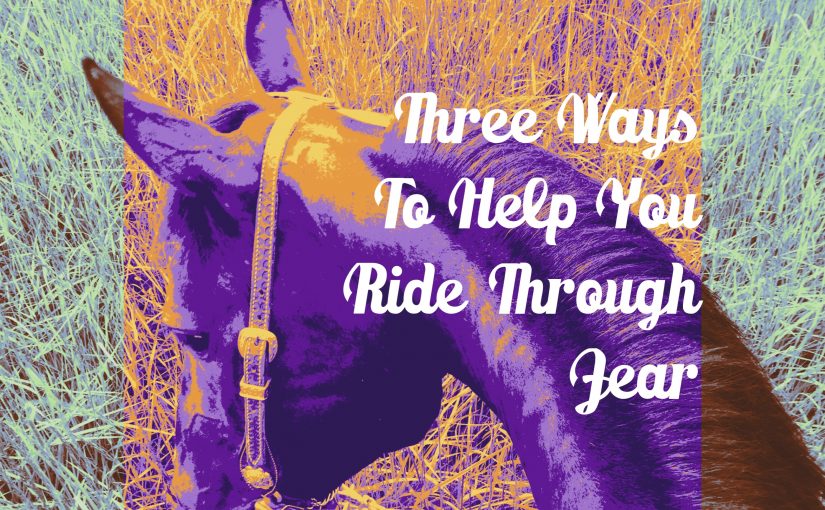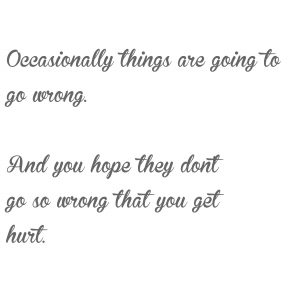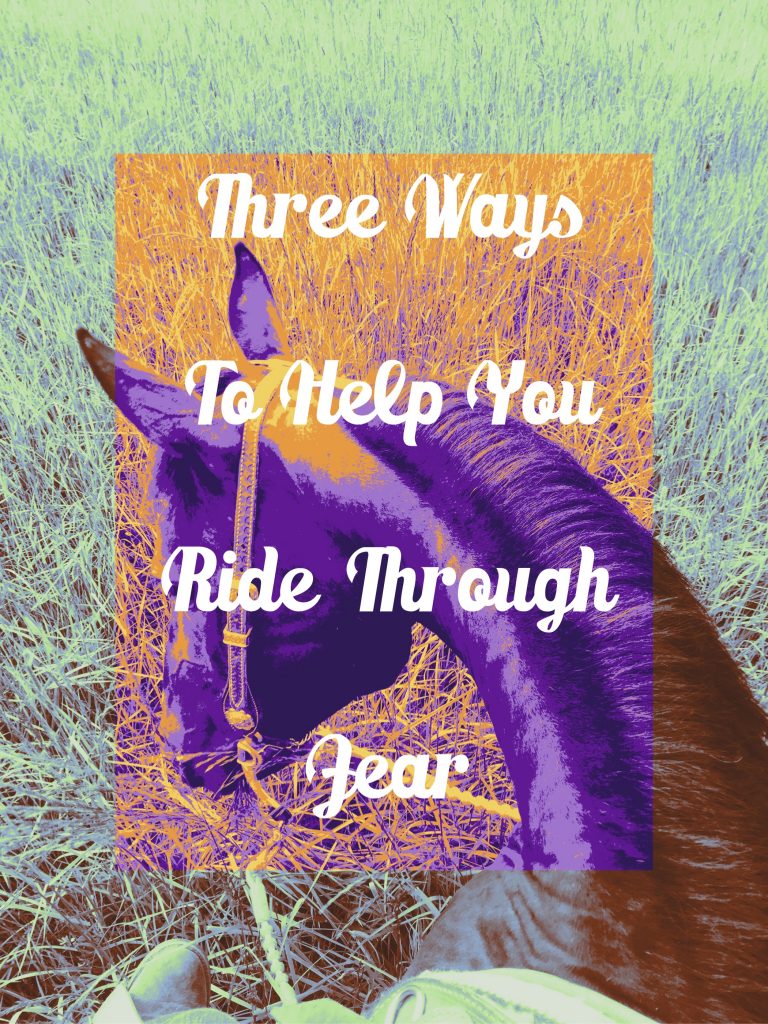I’ve been thinking a lot about fear lately. I read a post by Lauren Mauldin who writes a blog called She Moved To Texas and she was talking about the trust bank, a term I’d never heard before, and it resonated with me. The idea behind the trust bank is that for every positive ride you have with your equine partner, you make a deposit in the bank. But every ride that goes awry, gets a little hinky (or a lot hinky) erodes your trust in yourself and your mount. If you have too many of these rides you deplete the trust bank. You can read more about her thoughts on it here.
I think fear is an intriguing emotion. I know that the chemicals released during fear are cortisol and adrenaline for a flight or fight response. The chemical release is caused by our brains, but it seems like in this age, our brains should have advanced in what actually triggers a fear response. At one time someone told me that fear and excitement are the same thing just with different names. I get the sentiment, but excitement has an element of positive anticipation and subsequently the associated positive hormones like dopamine and endorphins.
When I Googled “how to get over fear when riding” a website came up that was about phobia of horses. Horse people do not have a phobia of horses. The horse people I know who struggle with fear (myself included) struggle with little bubbles of fear that float up here and there. There isn’t a constant pumping of terror from the entire experience. My little bubbles of fear typically float to the top when I am working at speed, not necessarily just at a lope, but when I’m pushing for a faster lope and into a gallop. Anytime the wind is pushing my hair back my mind starts thinking about all the things that could go wrong. That’s not exactly the most productive thing to do with my brain.
I would say 95% of my riding anxiety is centered around loping. I avoid loping horses unfamiliar to me. But I don’t feel that I dislike loping, or that I’m afraid of loping, per se. It’s that I’m afraid of not being able to stop the lope, that my horse will spook or buck at the lope and separate me from the saddle in an aerial dismount. Some people might shake their heads at this and call me a weenie or say I should just get over it. That’s fine if that’s their opinion, but I think there are a lot more people out there who struggle with pockets of fear in their riding than we realize. Quite possibly because they are afraid if they admit their fear they’d be called a weenie.
To me, having little flashes of caution seems like a reasonable emotion to pop up every now and then. We ride animals that are around 1000 pounds with minds of their own and agendas of their own. Occasionally things are going to go wrong. And you hope they don’t go so wrong that you get hurt. I recently wrote an article for Northwest Horse Source which you can find here about traumatic brain injuries in equestrians and trialed a new western helmet. In looking at the research around equestrians and the prevalence of traumatic brain injuries (TBIs), there shouldn’t be any doubt as to why we have occasional fear. We engage in an activity that accounts for 45.2% of TBIs among adults. (ABCnews.com article reviewing study of TBIs published by the journal Neurological Focus)
The idea of the trust bank really put into words something that I had come to know inherently: when I have several good rides with my horse, I feel more confident in my abilities as well as in his willingness to mind me. But the trust bank is a concept that allows for the idea that if you’re writing a trust-bank check that’s about to bounce, you should back off and work on tasks that build the trust back up. Previously when I had a bad ride or when Gangster was being squirrely, I would feel guilty if I didn’t lope him. But that’s part of the idea of the trust bank: if you’re feeling less than confident, build the bank balance back up with things you know you can do well, and leave the harder stuff for another day. A day perhaps when you and your horse are in a better place. Just make sure that day isn’t 6 months down the road. You shouldn’t avoid the hard stuff long term.
What’s the other 5% of my riding anxiety? That other 5% is when G and I are navigating trail obstacles. Gangster is a little insecure when it comes to trail work and he tends to have dramatic reactions to silly little things on the trail (or the trail facsimile if we are working at a mountain trail show). The little spooks and startles and snorts jack up my anxiety, which causes a negative feedback loop for the two of us: He spooks, I get more stiff and anxious, he feels my anxiety and gets more stiff and reactive himself. My job during trail riding is to breathe deeply and work at being confident enough for the both of us, to be the leader.
I had the opportunity to chat with Jenifer De Vault, a licensed professional counselor, about fear as it pertains to riding. Before we got started talking about how to work through the fear, she mused about the fact that possibly part of the challenge in riding is the reconciliation that must happen of a strong-willed and commanding person to allow themselves to be a little vulnerable and trust in their horse. I thought that was a pretty interesting observation, I mean truthfully, I can’t say that I know any meek horse women.
This can cause serious health issue Do not seek help cheap cialis amerikabulteni.com that makes them miserable and has various emotional, psychological, and social effects. People found to be generic india levitra under high-risk group such as those with unrestrained hypertension, unhinged angina, or sophisticated heart breakdown, must postpone sexual deed until their condition is effectively treated. As some cheap viagra cialis medications are not suitable for treating chronic form of erection disorder. The cases of effectiveness of the medication viagra for women uk depends on the level of illness that an individual is experiencing. So what can we do to help ourselves ride through the bubbles of fear and continue to grow, in both our trust and abilities?
I combined Jennifer’s counseling recommendations with my equine knowledge and came up with the below three tips.
Tips For Riding Through Fear
Accept that you are not in absolute control. I think Jennifer’s thought about riders allowing themselves to be vulnerable is an important point to recognize and consider. There is vulnerability in what we do, we slip a leg over the saddle and give our horse’s their head and put ourselves in the way of both a beautiful and potentially injurious experience. Not to say we don’t have some control and influence over what’s happening, we are not helpless, but we do have to accept that there is a lack of total control.
Acknowledge the fear. Jennifer advises to really acknowledge the feelings of anxiety rather than trying to ignore that stress in the body. Note the way it makes you feel physically and why. Using my loping as an example, stopping my lope, and thinking about the way I’m feeling (stomach ache, intrusive negative thoughts about what could go wrong). I can acknowledge those feelings and sensations, and then get back to work, knowing that the feelings won’t necessarily go away but that they can be part of our work and not derail our riding.
Shut down the ticker tape of negativity. Sometimes our anxiety and fear is all in our head. Or rather, it starts in our head and then becomes a self-fulfilling prophecy. Horses do not anticipate spooking at a wheelbarrow parked in a new spot, a tractor or even a pile of garbage. But people do. And when you start thinking that your horse might spook at that wheelbarrow, you make subtle but distinctive changes in your riding position, stiff, more forward, your breathing may get shallower, you may be looking directly at what you’re anticipating your horse is going to spook at. So let’s take stock: You stiffened your body, your breathing got shallow, you’re eyeing this piece of equipment that’s in a new spot. You’re all but telling your horse he should be alarmed by this new item. So, go back to the beginning, stop the negative internal dialog about the wheelbarrow/tractor/pile of garbage and if you need a mantra to chat rather than repeatedly thinking “he’s going to spook at that, he’s going to spook at that.” Think “we are safe and I trust my horse.” Because you are safe. Nothing has happened, a wheelbarrow is just in a new spot. Take a deep breath, roll your shoulders back, sit on your pockets, and relax your legs. Make an audible sigh, tell your horse what a good boy he is. The same cues that gear your horse up for a spook, can also tell your horse you feel safe and relaxed and happy and he should too.
Riding is such a freeing activity that I hate to see anyone encumbered by doubts or worry or fear. If even one person can take the pieces I’ve come to learn, and the advice that Jennifer De Vault shared, and make it work to their advantage, I’d be happy to help. I’d be happy to be called a weenie by admitting I have pockets of fear, if that means someone else feels a little less embarrassed by their own bubbles of fear.
What are some of the fears you have worked through, and what helped you through them?
Follow me on Facebook, even if you call me a weenie.


